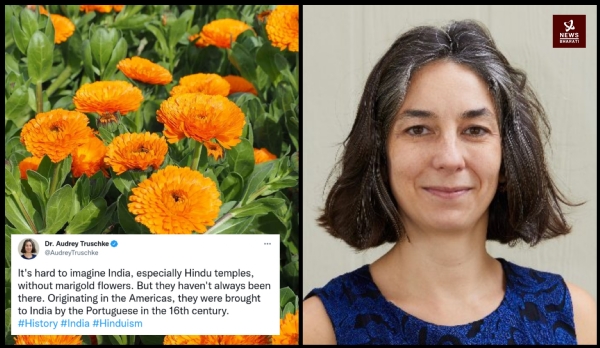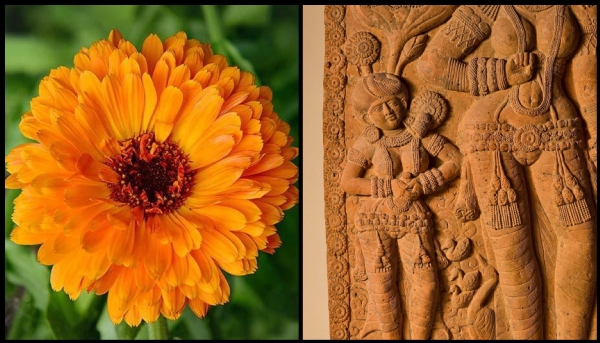Audrey Truschke at it again, claims #marigolds were brought to India by Portuguese! But here is the truth-
Audrey Truschke, the controversial so-called historian, has now claimed that marigold flowers did not exist in India until the Portuguese introduced them to India in the 16th century. Here is the truth
Total Views |
This article is based on a Twitter thread by Savitri Mumukshu
Audrey Truschke, the controversial so-called historian, has been in the headlines, of course for the wrong reasons. One of them is twisting Indian history, and misleading the public by sharing incorrect knowledge. Adding another such instance, she has now claimed that marigold flowers (गेंदे का फूल) did not exist in India until the Portuguese introduced them to India in the 16th century.

In a tweet, she said, "It's hard to imagine India, especially Hindu temples, without marigold flowers. But they haven't always been there. Originating in the Americas, they were brought to India by the Portuguese in the 16th century. #History #India #Hinduism".
Here is the truth of the marigold in India-
Though Audrey Truschke has once again distorted history with this baseless claim, the truth is far more different. First of all, Indians used marigolds for millennials but the species we used was Calendula officinalis (Pot Marigold) not the S. American Tagetes used today. It should be noted that Calendula Officinalis was known since ancient times all over the world as marigold or pot marigold in European literature. And, Tagetes were introduced in 1500s as French/African marigolds.
Calendulas got mixed up with Marigold in literature due to their similar appearance & colors. Precisely, Tagetes arrived after 1492, replacing calendulas in every culture from China to India to Europe to US. In Sanskrit the flower is called Jhaṇḍū (झण्डू) in the 14th c.text Rajanighantu, written by Narahari Pandita. The Rajanighantu itself was dated wrongly due to this confusion. Acharya P. Sharma dated the Rajanighantu to 17th century as it describes Jhaṇḍū (Marigold) & quotes Madanapalanighantu (1374 CE). But this confusion arose because in recent times Indians had started referring to Tagetes as Jhaṇḍū instead of the original Calendula flower.
Also Read: Delhi HC directs Twitter to remove 5 defamatory tweets by Audrey Truschke against Vikram Sampath
Notably, Narahari Pandita who wrote Rajanighantu was a disciple of Srikantha Pandita of Kashmir (1300-1360 CE) Narahari’s patron was Raja Narasimha 4 of Kalinga (r. 1378-1409 CE). Thus, Rajanighnatu was written between 1374 - 1409 CE, before the Portugese brought Tagetes to India. This proves Hindus used marigolds (Jhaṇḍū) long before the Portugese, but they used Calendula not Tagetes. Ancient terracotta plaques (300 -100 BCE) from Chandraketugarh, Bengal show clear visual evidence of Hindus using Calendula flowers as decorations since ancient times.

Rajanighantu classifies Jhaṇḍū as bitter & astringent. This is clinching evidence as Ayurvedic texts refer only to edible flowers. Calendulas are edible but marigolds are toxic if eaten. Calendula smell sweet unlike marigolds, as Hindus prefer fragrant flowers for worship.
Also Read: Historian Vikram Sampath’s Wikipedia page vandalised by Audrey Truschke supporters
For 1000s of years, Hindus used Calendulas as Jhaṇḍū (marigold) not Tagetes. Calendulas were the original marigolds before Portuguese brought Tagetes from S. America. Since Tagetes was prolific & easy to grow, it replaced Calendula all over the world & became the new marigold.
When the netizens tried to correct her, she tweeted, " Hindu Right Twitter has really lost it over me sharing a historical tidbit... about marigold flowers. Seriously.
It is a sign of how far they have gone on two parallel paths --
(1) denying history
(2) demanding adherence to their dangerous political narrative"
It is a sign of how far they have gone on two parallel paths --
(1) denying history
(2) demanding adherence to their dangerous political narrative"
However, Savitri Mumukshu, rightly said, "It is important to observe & call out historical inaccuracies in the right context. Duplicitous & unethical people like Audrey Truschke exploit confusion to distort facts & build fake Hindumisic narratives. Her objective as always is to trivialize India’s contributions to history. "
References:
Raja Nighantu & Dhanavantri Nighantu - Vaidya Narayana Sharma Purandare
Biography of Narahari, the author of Raja-Nighantu - PVV Prasad & A. Narayana
Journal of European Ayurvedic Society Vol 2, 1992

